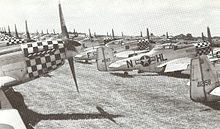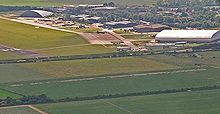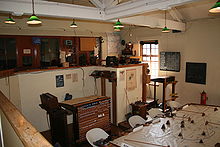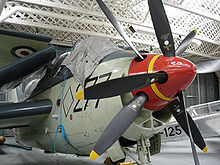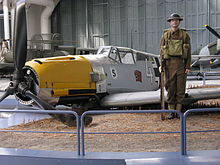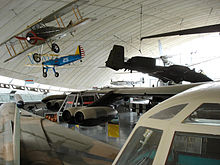- Imperial War Museum Duxford
-
Imperial War Museum Duxford 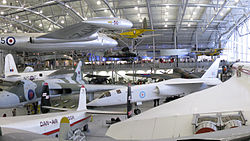
AirSpaceEstablished 1977 Location Imperial War Museum Duxford
Cambridgeshire
CB22 4QR
United KingdomVisitor figures 399,122 (2010)[1]
Director Richard Ashton Public transit access Stagecoach C7 from Cambridge. Website duxford.iwm.org.uk Imperial War Museum network Churchill War Rooms · HMS Belfast · Imperial War Museum Duxford · Imperial War Museum North Imperial War Museum Duxford (commonly referred to simply as "Duxford") is a branch of the Imperial War Museum near the village of Duxford in Cambridgeshire, England. Britain's largest aviation museum,[2] Duxford houses the museum's large exhibits, including nearly 200 aircraft, military vehicles, artillery and minor naval vessels in seven main exhibitions buildings.[3] The site also provides storage space for the museum's other collections of material such as film, photographs, documents, books and artefacts. The site accommodates a number of British Army regimental museums, including those of the Parachute Regiment (named Airborne Assault) and the Royal Anglian Regiment.
Based on the historic Duxford Aerodrome, the site was originally operated by the Royal Air Force (RAF) during the First World War. During the Second World War Duxford played a prominent role during the Battle of Britain and was later used by United States Army Air Forces fighter units in support of the daylight bombing of Germany. Duxford remained an active RAF airfield until 1961. After the Ministry of Defence declared the site surplus to requirements in 1969 the Imperial War Museum received permission to use part of the site for storage. The entirety of the site was transferred to the museum in February 1976.
In keeping with the site's history many of Duxford's original buildings, such as hangars used during the Battle of Britain, are still in use. Many of these buildings are of particular architectural or historic significance and over thirty have listed building status,[4] Duxford "retain[ing] the best-preserved technical fabric remaining from [a historic airfield] up to November 1918" and being "remarkably well-preserved".[5] The site also features a number of purpose-built exhibition buildings, such as the Stirling Prize-winning American Air Museum, designed by Sir Norman Foster. The site remains an active airfield and is used by a number of civilian flying companies, and hosts regular air shows. The site is operated in partnership with Cambridgeshire County Council and the Duxford Aviation Society, a charity formed in 1975 to preserve civil aircraft and promote appreciation of British civil aviation history.
Museum history
Main article: Imperial War MuseumThe Imperial War Museum originated during the First World War in 1917 as the National War Museum committee, formed by the British government to record the war effort and sacrifice of Britain and her Empire. The museum opened in 1920, by which point it had been renamed the Imperial War Museum.[6] With the outbreak of the Second World War, the museum's terms of reference were enlarged to include the conflict.[7] The museum's terms of reference was broadened again in 1953 to include all modern conflicts in which British or Commonwealth forces were engaged.[8] The effect of these expansions of remit was to cause the museum's collections to expand enormously, to the point that many parts of the collection, especially those of aircraft, vehicles and artillery, could not be effectively stored or exhibited. Although the museum's south London home (a nineteenth century building in Southwark which was previously the Bethlem Royal Hospital) had been extended in 1966, by the end of the decade the museum was seeking additional space.[9]
RAF Duxford, a Royal Air Force fighter station had been declared surplus to requirements by the Ministry of Defence in 1969, and the museum duly requested permission to use part of one of the airfield's hangars as temporary storage. Duxford featured three double bay hangars of First World War vintage, which together provided over 9000 m2 of space. Within two years, ten of the museum's aircraft had been brought to Duxford, and were being restored by volunteers of the East Anglia Aviation Society. While the museum's own aircraft were not restored to flying condition, by cooperating with private groups the museum was able to mount its first airshow in 1973. Further air shows followed, with a display in June 1976 attracting an audience of 45,000 people. The runway was bought by Cambridgeshire County Council in 1977. The success of these shows provided a valuable source of revenue, and complemented the efforts of volunteers, so that the museum applied for the permanent transfer of the entire site to its use. Permission was received in February 1976 and Duxford became the first outstation of the Imperial War Museum. Initially open from March-October, Duxford received 167,000 visitors in the 1977 season, and 340,000 in 1978. Two million visitors had been received by 1982[10] and Duxford welcomed its ten millionth visitor in August 2005.[11]
Duxford aerodrome
Main article: Duxford Aerodrome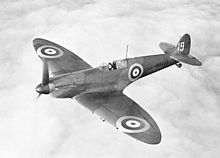 K9795, a Spitfire Mk I operated from Duxford by No. 19 Squadron in 1938.
K9795, a Spitfire Mk I operated from Duxford by No. 19 Squadron in 1938.
Duxford has been associated with British military aviation since 1917, when a site near the village of Duxford, in southern Cambridgeshire, was selected for a new Royal Flying Corps training aerodrome. From 1925 Duxford became a fighter airfield, a role it was to retain until the end of its operational life, and in August 1938 the Duxford-based No.19 Squadron RAF became the first to operate the Supermarine Spitfire.[12][13][14]
With the outbreak of war in September 1939 Duxford was home to three RAF squadrons engaged on coastal patrol duties. From July 1940, Duxford saw considerable action during the Battle of Britain as a sector station of RAF Fighter Command's No. 12 Group. In the middle years of the war Duxford was home to a number of specialist units, such as the tacticians and engineers of the Air Fighting Development Unit.[15] In April 1942 the first Typhoon Wing was formed at Duxford. Notable among the pilots of the Wing was Group Captain John Grandy who would later rise to be Chief of the Air Staff and also served as Chairman of the Trustees of the Imperial War Museum from 1978-89.[16]
In March 1943 the United States Army Air Forces' 78th Fighter Group started to arrive at Duxford with their P-47 Thunderbolts. The Group reequipped with P-51 Mustangs in December 1944 and until the end of the war in Europe the Group remained at Duxford carrying out bomber escort and fighter sweeps, ground strafing and ground attack missions.[17]
Duxford was officially returned to the RAF on 1 December 1945. It remained a fighter station but by 1958 changing defence priorities saw the RAF's fighter force move to more northerly bases. Duxford's last operational flight was made in July 1961. No longer operational, the site gradually became increasingly derelict and overgrown. In 1968 the American film studio United Artists obtained permission to use the site for the filming of Battle of Britain. During the shoot a single bay hangar, which had been built during the First World War, was demolished to simulate an air raid.[18] After the Ministry of Defence announced its intention to dispose of Duxford plans were drawn up for various developments including two Young Offenders Institutes but were not implemented.[19]
Duxford Aviation Society
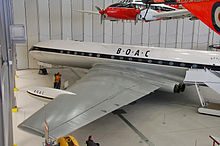 The Duxford Aviation Society Comet 4 on display in AirSpace.
The Duxford Aviation Society Comet 4 on display in AirSpace.
Duxford is operated in partnership between the Imperial War Museum, Cambridgeshire County Council and the Duxford Aviation Society. The Society was formed in 1975 after a divergence of members of the East Anglian Aviation Society,[20] which now operates the Bassingbourn Tower Museum[21] at the former RAF Bassingbourn. The Society is a registered charity (No. 285809) and states two objectives; to educate the public by collecting and exhibiting historic aircraft, military vehicles and boats, and to support the Imperial War Museum.[22] Especially notable aircraft in the Society's collection include a de Havilland Comet which made the first eastbound jet-powered trans-Atlantic passenger flight on 4 October 1958, and Concorde G-AXDN 101, a pre-production aircraft which achieved the highest speed of any Concorde, making a westwards trans-Atlantic flight in two hours, 56 minutes.[23] Since January 1999, the Museum and the Society have operated the Friends of Duxford membership scheme.[20][24] The Society's radio section, the Duxford Radio Society, collects, preserves, exhibits, and demonstrates historic military electronic equipment. This is housed in Buildings 177 and 178, close to the Gibraltar Gun.[25] In 2008, the Duxford Aviation Society had almost 700 members, supporting as volunteers activities such as aircraft conservation, learning and interpretative activities and administrative tasks.[26]
Air shows and flying
Hurricanes and Spitfires of the Battle of Britain Memorial Flight at the Duxford Air Show, May 2007.
Duxford remains an active airfield (IATA: QFO, ICAO: EGSU) and maintains two parallel runways; an unpaved 880 m grass strip, and a concrete runway with a usable length of 1199 m, both oriented at 060/240-degrees.[27] The runway was originally purchased from the Ministry of Defence by the Cambridgeshire County Council in 1977. In October 2008, an agreement was reached between the council and the Imperial War Museum, under which the runways and 146 acres (0.59 km2; 0.228 sq mi) of surrounding grassland would be sold to the museum for approximately £1.6 million.[28]
Since 1973, Duxford has held regular air shows. Duxford is the home of a number of private aviation companies, such as Classic Wings,[29] The Fighter Collection,[30] the Old Flying Machine Company[31] and The Aircraft Restoration Company.[32] Between them these companies provide pleasure flights, historic aircraft for film or television work, and aircraft restoration services. Perhaps the most notable privately-owned and operated aircraft based at Duxford is B-17 Preservation Ltd's Sally B, the only airworthy B-17 Flying Fortress in Europe.[33]
Major air shows held regularly include the Duxford Air Show, the Flying Legends show (organised by The Fighter Collection), and American Air Day, which is held in conjunction with units of the Third Air Force (part of the United States Air Forces in Europe), based at nearby RAF Lakenheath and RAF Mildenhall.[34] The Duxford Air Show usually exhibits a wide range of aircraft, from vintage warbirds to contemporary jet aircraft, along with aerobatic flying by groups such as the Red Arrows.[35] while the Flying Legends show focuses on historic aircraft, especially those of the Second World War.[36] In 2008 it was reported that these displays generate up to £1.8 million, while the loss of up to £100,000 due to adverse weather is also budgeted for. The policing bill, necessary to manage the resulting road traffic, was reported as some £8,000.[2] Recent major events have included the Battle of Britain 70th Anniversary airshow, held on 4-5 September 2010. The show was attended by more than 40,000 people,[37] and featured formation displays by four Hawker Hurricanes and sixteen Spitfires.[38]
As an active civil airfield, operations at Duxford are regulated by the Civil Aviation Authority (CAA). In 2002 a privately operated Aero L-39 Albatros suffered a braking failure on landing, overran the runway and came to rest on the M11 motorway, a student pilot being killed after ejecting at ground level. An Air Accidents Investigation Branch inquiry recommended a review of arrangements for aircraft taking off or landing towards the M11. As a result, the CAA and Duxford agreed to a reduction in the runway's 1500 m declared length, from 1350 m to 1200 m, in order to provide a greater margin of error.[39][40]
As a licensed airfield Duxford has its own Fire Service,(currently five vehicles, and 16 fire fighters / officers) which operates as part of the Airfield & Security department, the fire service was originally operated by voluntary crews who were part of Duxford Aviation Society, with the training officers coming from Stansted and other local airports, for the last few years it has been a wholetime operation.
Site layout
When originally planned in 1917, Duxford aerodrome was to occupy a 238-acre (0.96 km2; 0.372 sq mi) site divided by what is now the A505 road which runs north-east from Royston to Newmarket. The area north of the road would be occupied by accommodation and administrative buildings with the airfield, hangars and technical buildings on the south side. Still divided by the A505, the museum's site is now bounded to the east by the M11 motorway, which meets the A505 adjacent to the museum site at Junction 10. The construction of the M11 in 1977 forced the shortening of the runway by 300 m. In its role as a museum, the north side of the site is occupied by the Imperial War Museum's stored collections and is not generally open to the public, while the south side is occupied by various hangars and other historic buildings, purpose-built structures, and by two runways.
The south side visitor entrance, which now houses a shop and visitor facilities, was previously the airfield's armoury.[41] The various buildings are arranged roughly parallel to the A505; AirSpace is furthest east, with Hangars 2, 3, 4 and 5 running westwards, followed by the American Air Museum and the Land Warfare Hall. The museum site is approximately 1800 m from one end to the other, and a visitor bus operates during opening hours.[42][43]
A number of aircraft and other exhibits are displayed externally, such as a Comet tank and replica Hawker Hurricane as gate guardians at the main entrance. Several commercial airliners belonging to the Duxford Aviation Society stand on the runway apron opposite the hangars. A Bloodhound surface-to-air missile stands on the site of the demolished hangar. A United States Air Force F-15 Eagle stands near the American Air Museum. A Royal Engineers' Centurion AVRE stands outside the Land Warfare Hall and the Gibraltar Gun,[44] a 9.2-inch artillery piece previously emplaced on the Rock of Gibraltar is nearby.[3]
As an historic site, many of Duxford's buildings are of particular architectural or historic significance. In 2005, following a review of sites relating to British aviation history by English Heritage, some 255 buildings at 31 sites received listed building status.[5] Duxford contains over thirty of these buildings,[4] the largest number at any one site.[45] Listed buildings include three hangars dating back to the First World War and the operations block, which received Grade II* status. This block, open to the public, houses the wartime operations room from which Duxford's aircraft were directed.[41]
AirSpace
In 2000, Duxford announced plans for the redevelopment of Hangar 1, previously known as the 'Superhangar', which was built in the 1980s. The plans would expand the building by 40%, providing more display and conservation space, improve internal conditions, and enable the museum's British and Commonwealth aircraft collection to be brought under cover.[46] Planning permission was received later that year.[47] The project cost £25 million and was supported by the Heritage Lottery Fund, the East of England Development Agency and BAE Systems, which contributed £6 million. The building, which provides 12,000 m2 of floor space,[48] consists of an aircraft conservation area, a large exhibition hall, and a mezzanine providing views of the aircraft and interactive educational installations exploring aeronautical engineering and the principles of flight.[49][50]
AirSpace officially opened to the public on 12 July 2008.[51] Over thirty aircraft are on display, dating back to the First World War; notable early aircraft include rare examples of an Airco DH.9 and an Royal Aircraft Factory R.E.8. The former is one of only six surviving DH9s and the only example on display in the UK,[52] and the latter is the only complete and original R.E.8 in existence.[53] More recent notable aircraft include a Hawker Siddeley Harrier which served during the Falklands War with No. 1 Squadron RAF, and a Panavia Tornado, which flew the highest number of bomber sorties of any Tornado in the 1991 Gulf War.[54] Also on display is a British Aircraft Corporation TSR-2 strike aircraft, one of only two survivors from the cancellation of the project in 1965.[55] Recent additions include Eurofighter Typhoon DA4, one of seven Typhoon development aircraft, which was gifted to the museum by the Ministry of Defence in 2008 and went on display in June 2009.[56] Notable civil aircraft include the Duxford Aviation Society's Concorde and Comet described above.[3]
Airborne Assault
Main article: Parachute Regiment and Airborne Forces MuseumAirSpace also houses Airborne Assault, the museum of the British Army's Parachute Regiment and airborne forces. Previously located at Browning Barracks near Aldershot, the museum opened at Duxford on 8 December 2008. The opening ceremony was led by Prince Charles, the Parachute Regiment's Colonel-in-Chief. The museum chronicles the history of British airborne forces from the Second World War to current operations in Afghanistan and cost £3 million.[57]
Hangar 2: Flying Aircraft
Hangar 2 is a double Type T2 hangar, erected in the 1970s. It occupies the site of a T2 hangar erected in the 1950s. It accommodates the flyable aircraft of Duxford's private aviation companies and allows visitors to see aircraft undergoing maintenance or restoration.[41]
Hangar 3: Air and Sea
Hangar 3, an original Belfast truss hangar, houses Duxford's maritime exhibition. The collection includes a number of notable vessels and examples of naval aircraft. Boats on display include Coastal Motor Boat 4, built by Thornycroft in 1916. She saw action during the Baltic campaign of 1918-19, and her commander Lieutenant Augustus Agar won the Victoria Cross[58] for sinking the Russian cruiser Oleg on 17 June 1919. Other vessels include the Vosper motor torpedo boat MTB-71, acquired from the British Military Powerboat Trust in 2005,[59] an example of an X-Craft midget submarine, and a wartime Royal National Lifeboat Institution boat, the Jesse Lumb. A variety of naval aircraft are on display, including a de Havilland Sea Vixen, Sea Venom, and Sea Vampire, and a Westland Wasp helicopter which was embarked on the frigate HMS Apollo during the Falklands War.[3][60]
Hangar 4: Battle of Britain Exhibition
Hangar 4 is one of Duxford's historic hangars, and now houses an exhibition exploring Duxford's history as an operational RAF airfield from the First World War to the Cold War. The early period is represented by a Bristol Fighter, a type operated by Duxford's No.2 Flying Training School from 1920. The latter period is represented by a Hawker Hunter which flew at Duxford with No. 65 Squadron RAF, a Gloster Javelin, the type which made the last operational flight at Duxford in 1961, and by a Hungarian Mikoyan-Gurevich MiG-21, a common Warsaw Pact jet fighter. Britain's air defence during the Second World War is particularly emphasised, with exhibits representing the Battle of Britain, the Blitz and the V-1 flying bomb offensive from 1944. Notable aircraft include a Messerschmitt Bf-109E which was flown during the Battle of Britain until forced down in Sussex due to engine failure. It is displayed as part of a tableau showing the crashed aircraft under guard. One unusual aircraft on display is the Cierva C.30A autogyro, which was used by 74 (Signals) Wing, based at Duxford, to test the calibration of coastal radar units.[15][61][62]
Hangar 5: Conservation in Action
Hangar 5, the westernmost original hangar, houses Duxford's aircraft conservation workshops.[63] Open to the public, the hangar allows visitors to see museum staff and volunteers at work on a variety of conservation tasks. Notable projects include a Mitsubishi A6M Zero fighter acquired from an American owner in 'jungle recovery' condition,[64] and a Royal Aircraft Factory R.E.8 now on display in AirSpace.[53] Duxford is a partner with the British Aviation Preservation Council in the National Aviation Heritage Skills Initiative, which has been funded since 2005 by the Heritage Lottery Fund and aims to provide training to volunteers supporting aviation heritage projects.[65]
American Air Museum
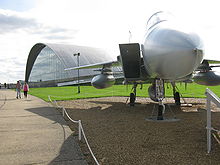 A US Air Force F-15 Eagle with the American Air Museum behind.
A US Air Force F-15 Eagle with the American Air Museum behind.
From the late 1970s the museum acquired a number of important American aircraft; a B-17G Flying Fortress in 1978, a B-29 Superfortress in 1980, and a B-52 Stratofortress in 1983. With Duxford's association with the US Army Air Forces, in the mid-1980s plans developed for a commemoration of the role of American air power in the Second World War. A group of American supporters was formed, and the architect Sir Norman Foster was commissioned to design a new building. Fundraising for the project began in 1987, support and funds being sought in the United States; the Founding Member was General Jimmy Doolittle in 1989. Fundraising events were held across the US in Houston (1989), Washington, D.C., (1991) and Los Angeles (1992). The project was widely supported in the United States by some 50,000 individual subscribers.[66] A further $1million of funding was secured from Saudi Arabia, and £6.5million from the Heritage Lottery Fund. On 8 September 1995 the groundbreaking for the new building was performed by wartime 78th Fighter Group veteran, Major James E Stokes.[67]
Architecture and construction
The American Air Museum was designed by Sir Norman Foster and constructed by Chris Wise at Arup. The museum's specification called for a landmark building that would provide a neutral backdrop for the aircraft collection and provide appropriate climatic controls while being cost efficient to operate. The building is shaped as a section of a torus,[68] formed from a curved concrete roof 90 m (300 ft) wide, 18.5 m (61 ft) high and 100 m (330 ft) deep. The dimensions of the building were dictated by the need to accommodate the museum's B-52 Stratofortress bomber with its 61 m (200 ft) wingspan and a tail 16 m (52 ft) high.[69] The roof was constructed as a double-layered concrete shell, built in 924 precast reinforced concrete sections. Inverted T-shaped sections provided the inner layer with further flat panels forming the outer layer.[70]
The roof weighs 6000 tonnes and is able to support suspended aircraft weighing up to 10 tonnes.[71] A glass wall, demountable to permit aircraft to be rearranged, allows in daylight, reduces lighting costs and enables the aircraft to be seen from the outside. It also allows visitors inside the museum to watch aircraft landing or taking off.[72] From a visitor's perspective, the pedestrian entrance leads to a mezzanine floor level with the cockpit of the museum's B-52, while the lack of supporting columns allows aircraft to hang from the ceiling. Heavier aircraft stand on the floor of the building, which covers 6,500 m2 (70,000 sq ft).[71][73] Construction began with the building of abutments in October 1995 and the roof was completed in September 1996.[74] The building won the 1998 Stirling Prize for Foster and Partners and was described by the judges as "a great big, clear span hangar of a building...dramatic, awe-inspiring, an object of beauty...simple yet replete with imagery."[75]
Opening and re-dedication
American Air Museum interior; F-111, left foreground, B-52 cockpit, right foreground, and SPAD S.XIII, PT-17 and A-10 Thunderbolt II, suspended above.
The American Air Museum was opened by Queen Elizabeth II on 1 August 1997. The total cost of the project had been £13.5 million.[67] The museum was re-dedicated on 27 September 2002, in a ceremony attended by former President George H. W. Bush and by Prince Charles. Since being opened, the museum had had its glass front removed, and then reinstalled, to allow the bringing-in of an SR-71 Blackbird[76] and B-24 Liberator.[77] The SR-71, serial number 61-7962, is the only example of its type on display outside the United States, and set a flight altitude record of 85,069 feet (25,929m) in July 1976. Besides the Blackbird, nineteen other American aircraft are on display. Notable examples include a C-47 Skytrain which flew with the 316th Troop Carrier Group and participated in three major Second World War airborne operations; the June 1944 Normandy landings, Operation Market Garden and Operation Varsity, the airborne crossing of the River Rhine in March 1945.[78] The museum's B-29 flew during the Korean War as part of the 7th Bomb Wing[79] and the B-52 flew 200 sorties during the Vietnam War as part of the 28th Bomb Wing.[80] The General Dynamics F-111 on display flew 19 missions during the 1991 Gulf War as part of the 77th Fighter Squadron.[3][81]
Land Warfare Hall
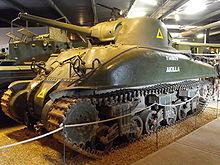 Canadian M4A1 Sherman tank
Canadian M4A1 Sherman tank
The Land Warfare Hall was opened on 28 September 1992[82] by Field Marshal Lord Bramall. The building provides accommodation for the Imperial War Museum's collection of armoured vehicles, artillery and military vehicles. Also included are vehicles belonging to the Duxford Aviation Society Military Vehicle Section.[3][83] The hall comprises a viewing balcony that runs for most of the length of the hall, providing views over a range of tableaux of vehicles, tanks and artillery that run chronologically from the First World War to the present day. Notable among the First World War exhibits is a battle-damaged artillery limber used by L Battery Royal Horse Artillery during an action at Néry in September 1914 where three Victoria Crosses were won. The Second World War in particular is illustrated with tableaux of the North African Campaign, the Eastern Front and the invasion of Normandy.[84] Significant vehicles in the collection include three command vehicles used by Field Marshal Bernard Law Montgomery, commander of 21st Army Group during the north-west Europe campaign. Also on display are extracts from Montgomery's personal papers, which are held by the Imperial War Museum's Department of Documents.[85] Other tableaux depict scenes from post-1945 conflicts such as the Korean War, the Northern Ireland Troubles, the Falklands War, British peacekeeping contributions in Bosnia and the Gulf War. As many of the vehicles in the Land Warfare Hall are maintained in running condition, the site features garages and a running area behind the building.
Forgotten War
The Land Warfare Hall also houses the Forgotten War exhibition, which opened on 25 March 1999 and was a joint project between the Imperial War Museum and the Burma Star Association. The Association represents veterans of the Burma campaign who often consider themselves to have fought in a "Forgotten Army" compared to those who fought in Europe. The exhibition explores aspects of the Second World War in the Far East and features artefacts, archival film and photographs, and tableaux depicting scenes such as troops moving through jungle and a Burmese village. The exhibition was supported financially by the Burma Star Association, and by £126,000 from the National Heritage Memorial Fund.[86][87]
Royal Anglian Regiment Museum and Memorial
The Land Warfare Hall also accommodates the Royal Anglian Regiment Museum. The Royal Anglian Regiment was formed in 1964 by the amalgamation of the three regiments of the East Anglian Brigade and the Royal Leicestershire Regiment. The museum was opened in June 1996 by noted war correspondent Martin Bell, who had previously served as a sergeant in the Suffolk Regiment while a national serviceman.[88] The museum covers the history of the Regiment and its predecessors, which date back to the seventeenth century, up to recent operations in Iraq, Afghanistan and Sierra Leone.[89] Alongside the museum is the Cambridgeshire Regiment Exhibition, which displays items from the Cambridgeshire Regiment collection. Exhibits include the Singapore Drums, lost at the fall of Singapore in 1942 and recovered after the war.[90]
On 12 September 2010 a Royal Anglian Regiment memorial was dedicated at Duxford. A fundraising campaign, which raised more than £340,000, was launched following the deaths in action of nine soldiers of 1st Battalion Royal Anglian Regiment during the unit's 2007 operational tour in Helmand Province, Afghanistan. The memorial is inscribed with the names of 78 soldiers killed since 1958 (when the first of the three East Anglian regiments was formed) in conflicts including Afghanistan, Iraq, Northern Ireland and Aden. The dedication was attended by more than 5000 people.[91]
North side: collections storage
In addition to the exhibition buildings, Duxford's 'North Side', the area of the site north of the A505 road, provides storage for the Imperial War Museum's collecting departments. The stored collections include the film collection, with potentially hazardous nitrate film kept in purpose-built vaults at nearby Ickleton. Other collections stored at Duxford's north side include books, maps, ephemera, photographs, documents and collections of uniforms and equipment.[92]
References
- ^ "VISITS MADE IN 2010 TO VISITOR ATTRACTIONS IN MEMBERSHIP WITH ALVA". Association of Leading Visitor Attractions. http://www.alva.org.uk/visitor_statistics/. Retrieved 2 March 2011.
- ^ a b Holt, John (September 2008) 'Air play' Museums Journal Vol.108 No.9 p.32-35
- ^ a b c d e f For a list of aircraft, vehicles and boats at Duxford, see "IWM Duxford: Aircraft and Vehicles". Imperial War Museum. June 2008. http://duxford.iwm.org.uk/upload/pdf/AircraftandVehicles.pdf. Retrieved 26 June 2009.
- ^ a b Imperial War Museum Duxford (2009) Historic Duxford. Accessed 15 September 2009.
- ^ a b Department for Culture, Media and Sport (2 December 2005) 'Chocks away! David Lammy secures a future for the aviation sites that protected our past' Press Release. Accessed 14 September 2009.
- ^ Kavanagh, Gaynor 'Museum as Memorial: The Origins of the Imperial War Museum', Journal of Contemporary History Vol. 23 No. 1 (January 1988). Available via JSTOR at [1]. Accessed 13 August 2009.
- ^ 'Imperial War Museum: Collection of war relics', The Times 14 May 1940 Issue 48615 Page 4 Column F
- ^ Imperial War Museum London (guidebook), (London: Imperial War Museum, 2009) pp. 2 ISBN 9781904897958
- ^ Frankland, Noble (1999). History at War. London: Giles de la Mare. p. 205. ISBN 9781900357104.
- ^ Frankland (1999) pg. 205-208.
- ^ National Museum Directors' Conference (September 2005) Newsletter No.48. Accessed 21 October 2009
- ^ Cheek, Tim (1998) 'Duxford: An unofficial history of one of the RAF's most distinguished airfields' Between the wars. Accessed 2 September 2009.
- ^ Imperial War Museum Duxford History of Duxford:1918-1924, 1925-36 and 1938-39. Accessed 2 September 2009.
- ^ Woolford and Warner (2008) Imperial War Museum Duxford (guidebook), London: Imperial War Museum ISBN 978-1-904897-72-9 p.21-28
- ^ a b Cheek, Tim (1998) 'Duxford: An unofficial history of one of the RAF's most distinguished airfields' Second World War. Accessed 3 September 2009.
- ^ Barrass, M B (2008) Air of Authority - A History of RAF Organisation Marshal of the RAF Sir John Grandy. Accessed 3 September 2009.
- ^ Cheek, Tim (1998) 'Duxford: An unofficial history of one of the RAF's most distinguished airfields' Second World War: American Period 1943-1945. Accessed 3 September 2009.
- ^ Cheek, Tim (1998) 'Duxford: An unofficial history of one of the RAF's most distinguished airfields' Battle of Britain. Accessed 4 September 2009.
- ^ Evans, Peter (8 July 1971) 'Need for 20 new penal centres in S E likely' The Times Issue 58219 pg. 3
- ^ a b Duxford Aviation Society Brief History. Accessed 15 September 2009.
- ^ Bassingbourn Tower Museum About. Accessed 15 September 2009.
- ^ No. 285809 - Duxford Aviation Society, Charity Commission charitycommission.gov.uk/. Accessed 15 September 2009.
- ^ Woolford & Warner (2008) p. 12 & 14.
- ^ Imperial War Museum Duxford Friends of Duxford. Accessed 15 September 2009.
- ^ Duxford Radio Society Home page. Accessed 15 September 2009.
- ^ Imperial War Museum Annual Report and Account 2007-2008. p. 24 Accessed 15 September 2009.
- ^ Imperial War Museum Duxford (2009) Airfield Information. Accessed 4 September 2009.
- ^ Thwaites, Glenn (9 October 2008) Duxford deal is run-a-way success, Cambridgeshire County Council Press Release. Accessed 1 September 2009.
- ^ Classic Wings Home page. Accessed 4 September 2009.
- ^ The Fighter Collection Home page. Accessed 4 September 2009.
- ^ Old Flying Machine Company Home page. Accessed 4 September 2009.
- ^ The Aircraft Restoration Company Home page. Accessed 4 September 2009.
- ^ B-17 Preservation Ltd: The Sally B Website Home page. Accessed 4 September 2009.
- ^ Royal Air Force Lakenheath (11 August 2009) Third annual American Air Day at The Imperial War Museum Duxford. Accessed 4 September 2009.
- ^ For example, see Johnson, Paul (September 2009) Flightline UK The Duxford Air Show 2009. Accessed 20 October 2009.
- ^ Fenwick, Simon (2009) Flightline UK Flying Legends 2009. Accessed 20 October 2009.
- ^ Culture24 (6 September 2010). "Thousands of fans enjoy Imperial War Museum Duxford’s Battle of Britain Air Show". http://www.culture24.org.uk/history+%26+heritage/war+%26+conflict/battle-of-britain/ART308275. Retrieved 1 November 2010.
- ^ "Duxford BofB show is a hit", Aeroplane Monthly (IPC Media): p. 7, 1 November 2010
- ^ Air Accident Investigation Branch (July 2003) Aero Vodochody L-39C Albatros, G-BZVL. Accessed 20 October 2009.
- ^ Civil Aviation Authority (7 August 2003) Follow-up Action on Occurrence Report. Accessed 20 October 2009.
- ^ a b c Duxford Update: A Duxford Buildings Tour www.Duxford-Update.info. Accessed 9 September 2009.
- ^ Imperial War Museum Duxford Duxford brochure p. 3 (site map). Accessed 9 September 2009.
- ^ Imperial War Museum Duxford Visitor Information: Accessibility. Accessed 9 September 2009.
- ^ 'Picture Gallery' photo caption: 'A 9.2-inch coastal gun is unloaded at the Imperial War Museum's outdoor display at Duxford Airfield, Cambridgeshire, after its journey from Gibraltar where during the last war it guarded the Straits'. The Times 8 August 1981.
- ^ 'Victory in battle for Britain's RAF heritage' (27 June 2005) The Daily Telegraph Telegraph.co.uk. Accessed 14 September 2009.
- ^ "Duxford's big plans". Air Classics (findarticles.com) (March 2000). http://findarticles.com/p/articles/mi_qa3901/is_200003/ai_n8895240. Retrieved 24 August 2009.[dead link]
- ^ "Duxford developments". Air Classics (findarticles.com) (October 2000). http://findarticles.com/p/articles/mi_qa3901/is_200010/ai_n8920247. Retrieved 24 August 2009.[dead link]
- ^ Parsons, Gary (2008) 'AirSpace takes off!' AirSceneUK.org.uk. Accessed 17 September 2009.
- ^ Selwood, Sara (October 2007) 'AirSpace, Imperial War Museum Duxford' Museums Journal Issue 107/10 pg.56-57
- ^ Cunningham, Justin (25 July 2007). "The sky's the limit". Professional Engineering 20 (14): 30. ISSN 09536639.
- ^ Oakey, Michael (Ed.) (Vol. 35 No. 9, September 2007) "Duxford's AirSpace opens". Aeroplane
- ^ Reynold, Nigel and Condron, Stephanie (20 April 2007) The Daily Telegraph 'Maharajah's bomber spreads its wings again'. Accessed 23 September 2009.
- ^ a b Gosling, Peter (October 2004) R.E.8 Restoration Flight Journal (findarticles.com). Accessed 14 September 2009.
- ^ Harrier GR3, serial XZ133 and Tornado GR1, serial ZA465. Woolford and Warner (2008) p.15
- ^ Parsons, Gary (2005) 'TSR2 cubed' AirSceneUK.org.uk. Accessed 28 September 2009.
- ^ 'IWM Duxford unveils new Eurofighter Typhoon exhibit' (22 June 2009) culture24.org.uk. Accessed 10 December 2009.
- ^ Smith, Michael (7 December 2008). "New museum honours Parachute Regiment". London: timesonline.co.uk. http://www.timesonline.co.uk/tol/news/uk/article5294113.ece. Retrieved 24 August 2009.
- ^ Agar's Victoria Cross, and a number of his personal effects such as a telescope, are also held by the museum.
- ^ British Military Powerboat Trust MTB-71: 60ft Vosper Motor Torpedo Boat Accessed 11 September 2009.
- ^ Woolford and Warner, p. 33
- ^ See also Imperial War Museum Duxford Hangar 4: The Battle of Britain and The Battle of Britain Exhibition. Accessed 10 September 2009.
- ^ Duxford Update: Hangar 4 www.Duxford-Update.info. Accessed 10 September 2009.
- ^ Duxford Update: Hangar 5 www.Duxford-Update.info Accessed 14 September 2009.
- ^ Duxford gets a zero Air Classics (April 1999) (findarticles.com) Accessed 14 September 2009.
- ^ National Aviation Heritage Skills Initiative (2009) Nahsi.org.uk Homepage. Accessed 14 September 2009.
- ^ Dormer, Peter (14 August 1995). "Making a Mecca for the plane crazy". The Independent. http://www.independent.co.uk/arts-entertainment/art/news/making-a-mecca-for-the-plane-crazy-1596187.html. Retrieved 26 August 2009.
- ^ a b American Air Museum: History aam.iwm.org.uk. Accessed 23 August 2009.
- ^ For a demonstration of the building's geometry, see Foster+Partners [2]. Accessed 25 August 2009
- ^ Jones, Mike. "Foster Solves the Big Span Problem with Reinforced Concrete: AJ Feature: The Shell is the Core". The Architects' Journal (14 July 1993). http://www.ajspecification.com/Buildings/Section_Page/?CI_Building_ID=280&CI_Section_ID=1093&CI_Article_ID=312. Retrieved 26 August 2009.
- ^ Evans, Barrie. "Concrete in flight: AJ Feature: Shell Logic". The Architects' Journal (6 November 1997). http://www.ajspecification.com/Buildings/Section_Page/?CI_Building_ID=280&CI_Section_ID=1089&CI_Article_ID=311. Retrieved 26 August 2009.
- ^ a b Evans, Barrie. "Concrete in flight: AJ feature: The Story of Duxford". The Architects' Journal (6 November 1997). http://www.ajspecification.com/Buildings/Section_Page/?CI_Building_ID=280&CI_Section_ID=1091&CI_Article_ID=311. Retrieved 26 August 2009.
- ^ McGuire, Penny. "Flying colours - design of the American Air Museum in Duxford, England". The Architectural Review (findarticles.com) (February 1998). http://findarticles.com/p/articles/mi_m3575/is_n1212_v203/ai_20465299/. Retrieved 25 August 2009.
- ^ Duxford American Air Museum The Architects' Journal: Building library. Accessed 26 August 2009.
- ^ Evans, Barrie. "Concrete in Flight: AJ Feature: Raising the Roof". The Architects' Journal (6 November 1997). http://www.ajspecification.com/Buildings/Section_Page/?CI_Building_ID=280&CI_Section_ID=1090&CI_Article_ID=311. Retrieved 26 August 2009.
- ^ Niesewand, Nonie (20 November 1998) The Independent Architecture: Foster and his flying machine. Accessed 30 September 2008.
- ^ "Duxford Blackbird hand-over". Air Classics (findarticles.com) (September 2001). http://findarticles.com/p/articles/mi_qa3901/is_200109/ai_n8956723/. Retrieved 26 August 2009.[dead link]
- ^ "Liberator begins arriving at Duxford". Air Classics (findarticles.com) (August 1999). http://findarticles.com/p/articles/mi_qa3901/is_199908/ai_n8863973/. Retrieved 26 August 2009.[dead link]
- ^ Woolford and Warner (2008) p.47
- ^ B-29A-BN, serial 44-61748. Woolford and Warner (2008), p.49
- ^ B-52D, serial 56-0689. Woolford and Warner (2008), p.49
- ^ Serial 67-0120. Woolford and Warner (2008), p.51.
- ^ The Independent (29 September 1992) Photograph caption: 'Sentry duty at the Land Warfare Exhibition Hall which opened yesterday at the Imperial War Museum in Duxford, Cambridgeshire. The display contains 40 artillery pieces, more than 50 tanks, and military vehicles including three lorries used as a bedroom and offices by Field Marshal Montgomery in the Second World War'. independent.co.uk. Accessed 28 August 2009.
- ^ Duxford Aviation Society Military Vehicle Section. Accessed 28 August 2009.
- ^ Imperial War Museum Duxford Land Warfare Hall. Accessed 28 August 2009.
- ^ 'Montgomery documents',The Times 8 July 1982, Issue 61280, page 2 column A
- ^ Imperial War Museum Duxford. "The Forgotten War Exhibition". duxford.iwm.org.uk. http://duxford.iwm.org.uk/server/show/ConWebDoc.1186. Retrieved 24 August 2009.
- ^ "Forgotten War". Air Classics (findarticles.com) (June 1999). http://findarticles.com/p/articles/mi_qa3901/is_199906/ai_n8870342/. Retrieved 24 August 2009.[dead link]
- ^ Royal Anglian Regiment Museum Supporters. Accessed 16 June 2009.
- ^ Royal Anglian Regiment Museum A Tour of the Museum. Accessed 16 September 2009.
- ^ MacDonald, Patrick 'The History of the Cambridgeshire Regiment' Suffolk Regiment.org. Accessed 16 September 2009.
- ^ Collett, Amy (14 September 2010). "Royal Anglian memorial unveiled: we will never forget their sacrifices". PeterboroughToday.co.uk. Johnston Publishing Limited. http://www.peterboroughtoday.co.uk/news/local/royal_anglian_memorial_unveiled_we_will_never_forget_their_sacrifices_1_1156020. Retrieved 28 September 2010.
- ^ Imperial War Museum Duxford: Friends of Duxford: Events (2009) North Side Tour At Duxford, 27 May 2009. Accessed 20 September 2009.
External links
- duxford.iwm.org.uk - Official Imperial War Museum Duxford website
- www.iwm.org.uk - Official Imperial War Museum website
- www.das.org.uk - Duxford Aviation Society
- www.duxfordfire.org.uk - Duxford Airfield Fire & Rescue Service Website
British Aviation Museums England AeroVenture · Battle of Britain Memorial Flight · Bournemouth Aviation Museum · Brooklands Museum · de Havilland Aircraft Heritage Centre · City of Norwich Aviation Museum · Farnborough Air Sciences Trust · Flambards Experience · Fleet Air Arm Museum · Gatwick Aviation Museum · Imperial War Museum Duxford · Kent Battle of Britain Museum · Lashenden Air Warfare Museum · Lincolnshire Aviation Heritage Centre · Midland Air Museum · Museum of Army Flying · Museum of Berkshire Aviation · Museum of Science and Industry in Manchester · Newark Air Museum · Norfolk and Suffolk Aviation Museum · North East Aircraft Museum · Royal Air Force Museum Cosford · Royal Air Force Museum London · Science Museum · Shoreham Aircraft Museum · Shuttleworth Collection · Solent Sky · The Helicopter Museum · Yorkshire Air Museum
Isle of Man Northern Ireland Scotland Lists relating to aviation General Aircraft (manufacturers) · Aircraft engines (manufacturers) · Airlines (defunct) · Airports · Civil authorities · Museums · Registration prefixes · Rotorcraft (manufacturers) · TimelineMilitary Accidents/incidents Records Categories:- Museums in Cambridgeshire
- Archives in Cambridgeshire
- Military museums in England
- Norman Foster buildings
- Concrete shell structures
- Museums sponsored by the Department for Culture, Media and Sport
- Aerospace museums in England
- Military aviation museums in England
- Museums established in 1977
- Imperial War Museum
Wikimedia Foundation. 2010.

